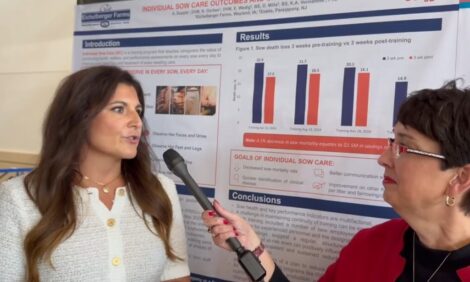



Searching for Alternatives to Antibiotic Growth Promoters
By the North Carolina State University - The use of antibiotics for growth promotion in swine feeds has come under serious scrutiny in the last few years due to concerns about their potential effects on antibiotic resistance in humans. This has led to a ban of growth-promoting antibiotics in Sweden in 1986, in Denmark in 1995 and 1999, and the decision by the EU to ban five antibiotics for growth promotion in 1999.These decisions were largely influenced by public and political opinions and the use of antibiotics for growth promotion in the U.S. may be influenced in a similar manner in the future.
Antibiotic growth promotants and pig performance
Considering data collected from 1978 to 1985, Zimmerman (1986) reported an average improvement in daily gain of 15 percent in nursery pigs and 3.6 percent in finishing pigs when antibiotics were included in the feed. Feed efficiency was improved by 6.5 percent in nursery pigs and 2.4 percent in finishing pigs due to antibiotics. A summary of the effects of antibiotic growth promotants on performance measures in nursery and growing-finishing pigs is presented in Table 1 (adapted from Cromwell, 2001).


Alternatives to antibiotic growth promotantsGeneral. Many alternatives to antibiotic growth promotants have been suggested (Table 3). However, studies evaluating their effectiveness are scarce. When evaluating alternatives to antibiotic growth promotants scientifically, it is important to use the proper experimental design. Treatments should include a diet without an antibiotic growth promotant, a diet with an antibiotic growth promotant, and a diet with the test product. This experimental design will allow the measurement of the effect of the antibiotic on performance, compared to the diet without antibiotic, and will further allow the evaluation of the effectiveness of the test product relative to the antibiotic treatment. Comprehensive studies comparing antibiotics and their alternatives are lacking.
In general, most alternatives to antibiotics are suggested to improve gut health and provide a more balanced gut microflora, ultimately improving pig performance. This is similar to the proposed mechanism of action of antibiotic growth promotants. Nonetheless, none of the potential alternatives
that have been proposed are as effective in improving growth as antibiotics. Thus, antibiotic alternatives would not do the job completely. Some reductions in performance parameters can be expected if growth-promoting antibiotics were to be removed as feed ingredients.
As indicated earlier, the greatest effect of antibiotic growth promotants is observed during the nursery period, and, therefore, most products to replace antibiotics are tested in the nursery phase. During this phase, pigs are weaned from the sow and transitioned from sow milk to a solid diet. It is a stressful period in the pig’s life that needs to be managed intensely. From a nutritional perspective, diets for the weaned pig have been extensively researched and are very complex.
Diet composition will likely play an even greater role in the absence of antibiotic growth promotants. The use of very digestible ingredients, free of antinutritional factors, will minimize gut epithelial damage and promote gut health. They are commonplace in diets for weanling pigs today, even with the inclusion of antibiotic growth promotants. Inclusion levels of some of these ingredients may need to be reevaluated in diets that do not contain antibiotics.
Zinc and copper. Both zinc and copper have antibacterial properties and have been shown to improve performance of pigs. Zinc oxide is added to diets of nursery pigs immediately
after weaning for up to two weeks to provide 2,000 to 3,000 ppm of zinc. These levels have been shown to reduce diarrhea and promote growth in weanling pigs. Copper at high levels (200 to 250 ppm) improved daily gain by 11.9 percent in nursery pigs and 3.1 percent in grow-finish
pigs, whereas feed efficiency was improved by 4.5 and 2.5 percent for these two phases of production, respectively (Cromwell, 2001). The response to copper can be observed in both the presence and absence of antibiotics; therefore, it cannot truly be considered an alternative for replacing antibiotics. It should also be noted that the addition of high levels of zinc and copper cause increased excretion of these minerals in feces and pose environmental concerns.
Plasma protein and egg yolk specific antibody. Spray-dried plasma protein is typically included in young pig diets because of its known stimulatory effect on feed intake and, subsequently, increased growth. It is speculated that these effects are due to immunoglobulins (antibodies) present in the plasma, which provide protection to the pig. Interestingly,
responses to plasma protein seem to be greater in animals that are housed in less sanitary conditions. Inclusion rates of plasma proteins may need to be reevaluated in the absence of antibiotic growth promoters in the feed. Specific antibodies
in eggs from hens that were inoculated with disease-causing agents commonly encountered in swine production may provide protection to the young pig against disease pressures and could enhance growth in the absence of antibiotics.
More research is required to verify the effectiveness of egg yolk antibodies as a potential antibiotic replacement.
Organic acids. Organic acids are often included in diets for swine as mold inhibitors, but they also have antimicrobial properties that can position them as potential replacements for antibiotics. In addition, they may reduce gut pH and stimulate digestibility, which can in turn improve feed efficiency.
Examples of organic acids are acetic, propionic, butyric, formic, citric, fumaric, lactic, sorbic, and malic acids or commercial acid blends. Mroz (2003) summarized the literature and reported an improvement in weight gain in nursery pigs of 3.7, 4.5, and 10.5 percent with the addition of citric, fumaric, and formic acid, respectively. Feed efficiency
was improved by 2.4 to 4.2 percent. In growing-finishing
pigs, weight gain was improved by 3.6, 3.8, and 6.2 percent with the addition of fumaric, propionic, and formic acid, respectively. Feed efficiency was improved by 2.8 to 4.8 percent. It should be noted that there were no direct comparisons between antibiotic and acid supplementation in this summary. Thus, the replacement value of these acids for antibiotic is not known, although the addition of acids did appear to improve performance. It should also be noted that currently the use of formic acid in diets for pigs is not approved.

Direct-fed microbials. Live bacterial cultures (or direct-fed microbials or probiotics or competitive exclusion cultures) have been proposed to improve the balance of the gut microflora.
Thus, the bacterial cultures added to the feed will compete with pathogenic bacteria for nutrients and binding sites on the intestinal wall, produce toxic compounds to Table 3. Potential antibiotic alternatives and their estimated relative effectiveness compared to antibioticgrowth promotantspathogenic bacteria, and promote an effective immune system.
Bacterial cultures may include Lactobacillus, Bacillus, Streptococcus, yeast, or other microorganisms. Considering the mode of action, direct-fed microbials would be a logical choice as antibiotic replacement strategies. Positive results have been obtained; however, direct comparisons with antibiotics
have shown limited effectiveness.
Prebiotics. Prebiotics are indigestible carbohydrates that can selectively stimulate the growth of beneficial bacteria and, therefore, improve pig performance. Examples are mannan-oligosaccharides, fructo-oligosaccharides and inulin. Variable
results have been obtained with the use of these compounds,
which may be related to specific farm condition. Other products. Enzymes, bioactive peptides, botanicals, and essential oils have all been proposed as antibiotic alternatives.
Research on these products is ongoing and should provide clarification on whether they will prove to be suitable
antibiotic alternatives.
Source: North Carolina State University Swine Extension - August 2005








